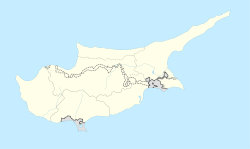Pallouriotissa
|
Pallouriotissa Παλλουριώτισσα |
|
|---|---|

Digeni Akrita avenue
|
|
| Location in Cyprus | |
| Coordinates: 35°10′28″N 33°22′37″E / 35.17444°N 33.37694°ECoordinates: 35°10′28″N 33°22′37″E / 35.17444°N 33.37694°E | |
| Country |
|
| District | Nicosia District |
| Municipality | Nicosia |
| Population (2011) | |
| • Total | 15,607 |
Pallouriotissa (Greek: Παλλουριώτισσα [locally [palːuˈr̥kotisːa]]) is an area of Nicosia, Cyprus, formerly an independent village, which was annexed to the municipality in 1968. It was subsequently divided into the quarters of Panayia (Panagia) and Saints Constantine and Helen (Agioi Konstantinos kai Eleni). As of 2011, their combined population was 15,607. Pallouriotissa is immediately south of Kaimakli.
The name refers to the plant Palliouros known today as Palloura in Cypriot Greek, i.e. the Jujube plant. According to popular tradition, an icon of the Virgin Mary (Panayia) was found hidden in the branches of a large palloura plant.
The settlement of Pallouriotissa, developed around the (female) monastery of the Virgin Mary of Pallouriotissa during the period of Lusignan rule in Cyprus, situated about a mile east of Nicosia. The year of foundation of the monastery is not verified, but the writer Stephen Lusignan puts its inception in the late 4th century AD, citing as founder St. Macedonius, who succeeded after St. Trifyllios as Bishop of Ledra and participated in the First Ecumenical Council of 325 AD.
The first historically documented testimony to the monastery is found in a sacred text that was written shortly after the martyrdom of thirteen monks of Kantara. Also important is the reference made by Archimandrite Cyprian in " Chronological History of the island of Cyprus", based on the historical references of Stephen Lusignan, referring to two monasteries, those of Empress Helen and Pallouriotissa.
In 1567 the Venetians strengthened the defences of Nicosia by building new walls on a shorter circumference and demolishing all the buildings outside of these in the vicinity. Thus the monastery was demolished. Some time after the Ottoman conquest the monastery was rebuilt this time for males. Last abbot of the monastery was Chrisanthos. With his death in 1888 the monastery fell into debt because of large amounts spent for the repair of the church, the water supply and taxes. Much of the monastery church collapsed after a fire, probably in the mid 19th century.
Gradually the church became the parish church for the village and it was rebuilt in 1887 and extended retaining only the walls in the apse of the sanctuary. In May 1890 the church was ready and was inaugurated by Archbishop Sophronius.
...
Wikipedia

